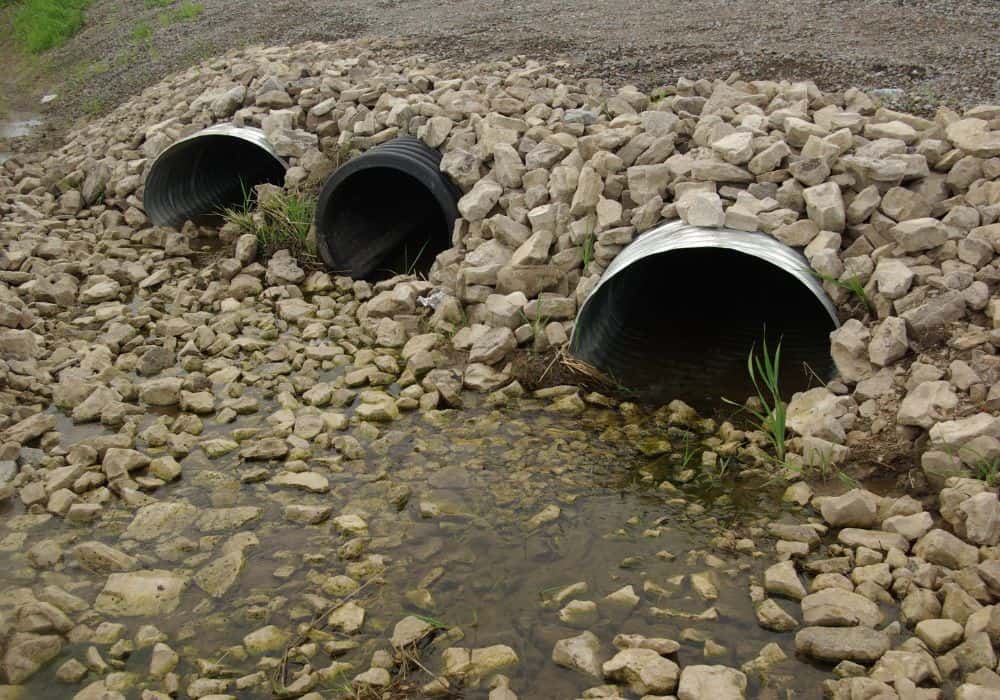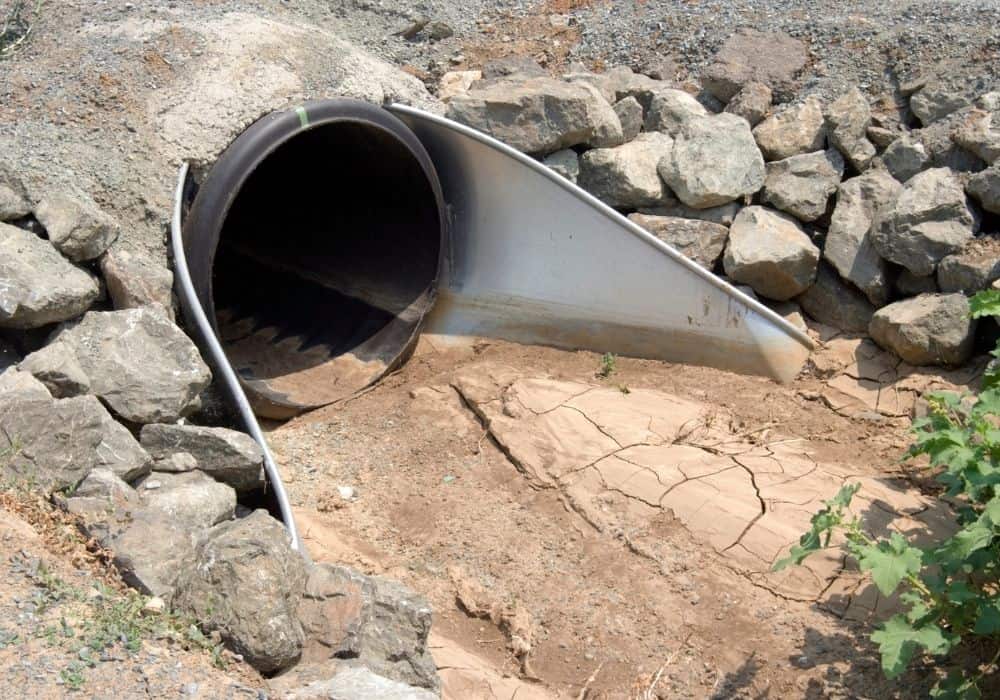Whether renovating your driveway or building it from scratch, installing a driveway culvert is crucial to prevent flooding and erosion. While installing a culvert on your driveway may not be daunting, choosing the best pipe is.
Driveway culverts come in various materials and types, each having varying features.
Besides considering a suitable material and type, several other aspects must be considered to choose the best pipe for the driveway culvert.
Let’s dig deep to understand what to look for in a driveway drainage pipe, making your search much more accessible and ensuring effective results.
What’s The Best Pipe For a Driveway Culvert?
Although pipes made of copper, concrete, and several other materials can be used as drain pipes, the most feasible and popular choices are PVC and conjugated plastic or steel pipes.
Aside from the right material, there are numerous other factors to consider so you can choose the best driveway culvert pipe.
Factors Affecting Pipes Under The Driveway
1. Vehicle’s Weight
Pipes installed under the driveways should ideally withstand the weight of the vehicles parked or moving through the driveway. Pick a sturdy material for the best results. On average, the weight of a car falls between the range of 2500 to 4500 pounds.
When searching for a drain pipe, ensure the material you pick is durable to withstand this weight without wear for several years; otherwise, you’ll end up replacing the pipe soon.
When installing pipes, ensure they are placed at least 12 inches deep from the surface for added stability and to endure the weight with no issue.
2. Changes In Temperature
Plastic pipes can expand or contract 5 times more than metal pipes (steel, iron, etc.). These changes can eventually wear the pipes, leading to leaks.
For example, PVC pipes can shrink in cold weather, increasing wear and tear. Opting for a perforated type can solve this issue without a hitch. In situations like these, ensure you choose a drain pipe compatible with the temperature changes.
3. Drainage Capacity

The water you want to drain influences the pipe’s type, size, and diameter.
For example, a PVC pipe with a half-inch diameter has more drainage capacity than a 5/8-inch drain pipe. Therefore, it’s imperative to know much water needs to be drained so you can choose a feasible culvert pipe.
Types Of Drainage Pipes
Familiarizing yourself with different drain pipes can further simplify your search and ensure proper functionality.
1. Corrugated Pipes
These pipes have grooves and ridges, allowing the pipes to be coupled with other pipe joints and bends without any problem. The grooves and ridges are placed parallel to the installation site. Corrugated pipes are a cost-affordable option if you want a budget buy.
The single-wall corrugated pipe is made of a highly durable plastic called HDPE. The pipe’s interior is smooth, allowing maximum water flow with a corrugated metal pipe exterior.
The material used is one of the strongest plastics. Their diameter ranges from a few inches to a maximum of 60-inches. Besides being durable, the pipe is lightweight and flexible, making it impact-resistant.
The dual wall corrugated pipe has two layers of HDPE fused for extra strength. The pipe’s exterior is weather-resistant and robust enough to withstand external elements, whereas the interior is designed to maintain a steady water flow.
There are further several types of dual-wall corrugated pipes. Therefore, do some research if you prefer installing a dual-wall corrugated pipe for your driveway.
2. PVC Drainage Pipes
Most commonly used indoors and outdoors for adequate water drainage. It’s the most sought-after type as it’s easy to install and maintain over the long run.
The PVC pipes used are made of a synthetic polymer that can withstand extreme weather conditions and are capable of handling more dirt and debris than an average indoor pipe.
Here are different types of PVC pipes you can use in a driveway culvert. PVC pipes are also called smooth-walled pipes as they allow easy water flow and are available in various diameters and lengths.
- PVC-U Pipes
While the standard PVC plastic is soft and flexible, the PVC-U pipe for drains is specifically manufactured to be rigid and highly durable.
- C-PVC Pipes
These pipes are chlorinated and a suitable option for a driveway drain. Besides being durable, the pipe is impact and corrosion-resistant. These features make the C-PVC pipe a feasible pick for drainage areas with a high water flow.
- PVC-O Pipes
This type is an upgraded variant of the C-PVC pipe. PVC-O pipes are the most durable, impact, and wear-resistant type. It’s an excellent choice for driveways dealing with heavyweight automobiles like buses and trucks.
3. Perforated Drain Pipes

PVC and corrugated pipes can either be solid or perforated. With improved drainage capability, perforated pipes are ideal for draining rainwater or stagnant water from lawns, yards, and other outdoor spaces.
As these pipes can easily remove rainwater with increased drainage capacity, they are considered a suitable option for a driveway culvert, especially in areas with high levels of rainfall.
Perforated pipes have small slits or holes, allowing easy water drainage. These small holes all over the pipe take in water from all sides, ensuring optimum performance in the rainy season.
However, these pipes need extensive maintenance, as the perforations can clog easily. Perforated pipe is the cheapest option available and is easier to replace than its counterparts.
Several other types of pipes used for a driveway culvert include copper, steel, cast iron, polyethylene, and concrete. However, these options are not effective enough.
For example, a copper pipe is exceptionally corrosion-resistant, whereas a concrete drain is preferred for industrial drains.
Concrete vs. PVC vs. Corrugated Pipes
While concrete pipes are used less often, corrugated and PVC pipes are the best pipes available for a driveway culvert. Each material has its own benefits and drawbacks, making them feasible for different situations.
For example, if you live in an industrial area or have your home near a road with heavy traffic, your choice should be a concrete pipe. Likewise, a PVC pipe is a good option if you have a small or medium-sized culvert.
Culvert Installation Under The Driveway
The driveway pipe runs from one end of your driveway to the other, ending in a drainage ditch. The pipe is placed horizontally under a trench drain or a channel drain. Here are the steps to follow for effective installation.
Tools You’ll Need
- A permit from local authorities
- Trench digging machine
- Measuring tape
- A drainage pipe with a suitable drainage capacity
- A shovel
- Gravel
- Drain gate
Before you start the installation, you may need to file for a permit from local authorities. After receiving approval, contact the local utility company to know where lines are already buried.
Step 1: Measure and Outline
Measure the driveway culvert space with a measuring tape and outline the areas you will work at. Don’t forget to measure the depth and length where the pipe will be installed.
Ideally, the pipe should be at least 12-inches deep in the trench and at a safe distance from the home’s foundation.
You can use strings and stakes for a precise and straight trench.
Step 2: Digging The Trench
You can use a shovel if you have a smaller driveway reinforced with creek and gravel. However, a trench-digging machine would be best for a deeper, longer trench. You can call a construction worker or a plumber to operate the equipment safely.
After digging the trench, ensure the surface is smooth for the pipe to easily fit in. Lastly, check any object left in the drainage pipe and remove it before making the final adjustments.
Step 3: Pipe Installation
Whether your driveway system is small or long, the best options are always PVC and perforated pipes. Before placing the pipe, compact the soil to prevent pipe shifting. Place the pipe inside the trench and ensure it’s level.
When using a perforated pipe, carefully cover the holes with soil to avoid clogging. Don’t forget to install a debris filter on both ends of the pipe and a drain gate for improved efficiency and easy maintenance. When burying the pipe, ensure you apply gravel on both sides to keep it sturdy.
A dirt-gravel mix can also be used for burying the pipe. The final step includes applying asphalt or gravel on the driveway’s surface.
This process of drain pipe installation may not be easy for everyone. It needs technical knowledge and the capability to carry out the installation. Therefore, getting professional help from your contractor or a drain installation service is advised for the best results.
Preventing Blockage
- Different types of pipes require different levels of maintenance. Don’t avoid maintaining the pipes. You can either DIY or call in professionals for pipe maintenance.
- Ensure drain covers are always in place as objects can flow in, resulting in a blocked drain.
- Use filters and clean them regularly.
Failing to maintain driveway culverts will make matters worse over time, resulting in a massive blockage that may require calling in professional pipe cleaning services.
Final Thoughts
Your driveway culvert project will become a breeze if you know your requirements. These include understanding your drainage needs, weather conditions, and the type, material, and dimensions of the pipe required for the project.
The information presented here can assist you in better understanding your requirements and making the best choice.

Which type of culvert is recommended for homes in Canada. The frost caused mine to raise.
Thank you for your time.
Kim